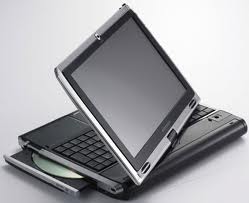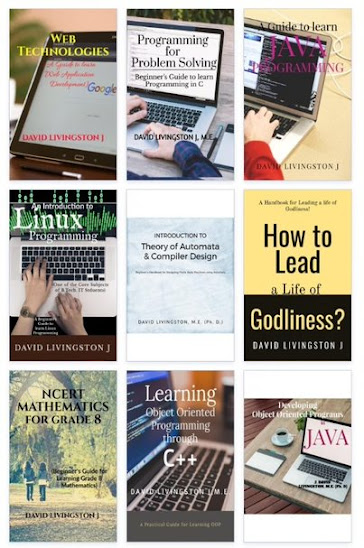GENERATIONS OF COMPUTERS!

The early computers, which used vacuum tubes to control the flow of electronic signals, are called
First Generation Computers. The computers of this generation are: ENIAC, EDSAC, EDVAC and UNIVAC. These computers used thousands of Vacuum tubes to do the entire operation.
Vacuum Tube is an electronic device that used filaments for producing electronic signals. Its size is about the size of an electric bulb. It produced lot of heat and burn out frequently. Because of the use of Vacuum tubes, first generation computers were too bulky and failed to work too often.
FIRST GENERATION COMPUTERS

The
ENIAC (1943-1946), called Electronic Numerical Integrator And Calculator was the first electronic computer. It was completely developed in 1946 by a team led by Eckert and Maucly at the University of Pennsylvania in U.S.A. ENIAC used high-speed vacuum tube switching devices for the control of electronic signals. There were about 19,000 vacuum tubes in ENIAC. It had a very small memory and used wired plug boards as input devices. ENIAC took about 200
µs to add two digits and 2800
µs to multiply. It was primarily designed to calculate the trajectories of missiles.
The computers EDSAC and EDVAC, which were developed after the ENIAC, were called as ‘Stored Program’ computers, because they were designed to store instructions and data internally after the proposal of Von Neumann in the year 1946. His idea was to store machine instructions in the memory of the computer along with data.
EDSAC (1947-1949), abbreviation for Electronic Delay Storage Automatic Computer, was the first stored program computer. It was developed by a team of Scientists led by Prof. Maurice Wilkes at Cambridge University, U.K. This machine used mercury delay lines for storage.
EDVAC (1946-1952) is the abbreviation for Electronic Discrete Variable Automatic Computer (EDVAC) was the first effort made on the concept of Van Neumann. It used binary form (i.e., 0 and 1: called discrete or digital signals) to store data and instructions of the decimal number system used by human beings.
Computers, which operate on discrete or digital signals like 0 and 1, high or low are called Digital Computers, whereas Analog computers operate on analog signals, which are continuously varying in nature. Some of the examples for Analog device are Voltmeter, Ammeter and Speedo meter. EDVAC is an example for Digital computer, which used binary values 0 and 1 for storage and calculation.
Universal Automatic Computer (UNIVAC) was the first computer produced for commercial purpose. It was developed in 1951. It was available for commercial use from 1954.
SECOND GENERATION COMPUTERS
Bardeen, Brattain and Shockley invented transistor in 1947. Transistors are made of Germanium Semiconductor material. Compared to vacuum tubes, transistors were highly reliable, occupied less space and used only one tenth of the power required by tubes.
The computers, which were made of transistors, are called Second Generation computers. They were introduced around 1959 and lasted till 1965. The use of transistors made ‘second’ generation computers faster, smaller and reliable.
Magnetic Core Memory
Memories were also invented during second-generation of computers. Magnetic core memories were made up of magnetic cores, which are tiny rings (0.02 inch diameter) made of ferrite. They are magnetized in either clockwise or anticlockwise direction to represent 0 and 1. This type of memory was used to construct RAM up to the size of 100 KB.
Other Developments
Magnetic disk storage was developed during this period.
Higher level languages - FORTRAN, COBOL, ALGOL and SNOBAL were introduced.
The early operating system called Batch Operating System was developed during this time. For e.g., the Batch OS used in IBM 7000 series computer.
Commercial applications like Payroll, Inventory Control, Marketing, Production Planning and General Ledger were rapidly developed.
THIRD GENERATION COMPUTERS
Integrated Circuits (ICs) were used as the switching device in third generation computers. Germanium transistors were replaced with Silicon transistors in the construction of CPU. Because of the use of Silicon transistors in ICs, the switching speed and reliability of CPU increased by a factor of 10. Power dissipation and the size of CPU were decreased by a factor of 10. This resulted in increase in speed of the third generation computers was 1 MIPS. The System/360 introduced by IBM around 1965 was the first third generation computer.

An IC is a small chip consists of electronic components like transistors, resistors and capacitors on a silicon metal plate. The components were integrated together on a silicon material in order to eliminate the wired interconnection between components. The technologies used for the construction of ICs of third generation were SSI and MSI. SSI technology can integrate about 10 transistors in a chip. The integration capacity was increased 10 times in MSI technology to hold up to 100 transistors in one chip.
Other Developments
Time-sharing OS like multiprocessing, multiprogramming and multi-user OS were introduced to increase programmer productivity.
The High-level language PL/1 of IBM was emerged. Many important on-line systems like dynamic Production control system, Airline reservation system, and Interactive query system were implemented.
Significant improvements were made in the design of Core memories. As a result, the size of the main memory reached about 4 MB. Magnetic disk memory was also available up to the size of 100 MB.
The standard I O devices keyboard and monitor were newly introduced.
FOURTH GENERATION COMPUTERS
Fourth generation computers used LSI and VLSI technologies for the construction of CPU, memory and supporting chips. The VLSI chip used as the switching device in fourth generation computers is called Microprocessor (P). Introduction of microprocessor as CPU in the fourth generation computer led to the following developments:
Extremely powerful Personal Computers (PC) were emerged.
Computer cost came down rapidly.
Computer’s workload was decentralized. As opposed to a Mainframe computer, which uses a single powerful CPU to be shared by many terminals for many applications, a PC has its own P to do its processing and can be connected in a network.
LSI & VLSI Technologies
In LSI Technology, thousands of components were fit onto one chip, whereas in VLSI technologies, 10 to 50 thousands of transistors were integrated onto a single chip. The ability to fit so much onto an area about half the size of one-rupee coin helped diminish the size and price of computers. The other developments that took place during fourth generation are as follows:
Magnetic Core memories were replaced by Semiconductor memories for the construction of RAM. Thus RAM with the size of 16 MB and a cycle time of 200 ns were in common use.
Hard disk size for the secondary storage was greatly improved in the order of Giga Bytes. 1 GB of disk on PCs became common in 1994.
Optical disks like CD-ROM and DVD-ROM (Digital Versatile Disk ROM) emerged as mass storage devices particularly for read only files. The size of the disk was of the order of 600 MB on a 5.25” disk.
High-level languages such as C, C++, ADA and PROLOG were developed. CASE tools were also developed for the Analysis and Design of software.
Interactive graphic devices and language interfaces to graphic systems were introduced.
FIFTH GENERATION COMPUTERS
The fifth-generation computers are under development. Fifth generation computers will make use of ULSI chips which consist of millions of components into a single IC. Such computers will use intelligent programming, knowledge-based problem solving techniques, high performance multiprocessor system and improved human-machine interfaces.
The input and output for these computers will be in the form of speech and graphic images. Vision system will be incorporated in order to perceive the surroundings. The computers of this age will be able to understand natural languages like English, Japanese, and Hindi. This will diminish the need for learning computer programming languages by programmers.
Using intelligent programming, the user can tell the computer what to do but not how to do. The computer will do the task of programming itself. The first four generations of computers used Von Neumann’s architecture for the design of digital computers. In Von Neumann architecture, a processor executes simple instructions in a sequence. But the fifth generation computers will use a different design and architecture.
Data flow architecture will be used as the basic design for the construction of fifth generation computers. There will be an extensive use of parallel processing and PROLOG is going to be the language for performing parallel processing. Special coprocessors will be used to make logical inferences and manage massive amounts of stored knowledge. In General, fifth generation computers will be knowledge-based computers.































